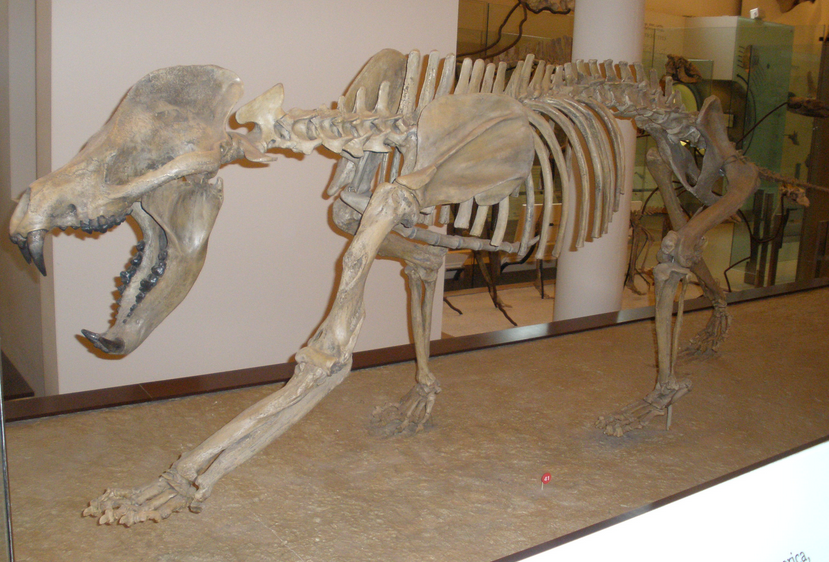A Diminished World of our Own Making
Published on April 7th, 2014
According to English ecologist and Guardian columnist George Monbiot, ongoing paleontological research is demonstrating ever more conclusively that the stunning rise of man has been accompanied by an equally stunning fall of gigantic creatures – the megafauna. There never was any “state of grace,” he suggests; man was always a “destroyer of worlds.”
Or as we might also put it, when it comes to early man, there was no “noble” in the “noble savage.” Early human hunter-gatherers did not reside in a Garden of Eden in a stable and respectful coexistence with their fellow creatures. Instead, they slaughtered them without foresight or remorse.
 |
|
Skeleton of extinct Amphicyonid (“bear dog”). |
As human populations multiplied, feeding on the flesh of felled prey, our hardy ancestors dispersed from Africa and peopled the planet. Simultaneously, there was an inexorable and parallel disappearance of numerous wildlife species right across the face of the Earth.
Many of these extinctions were of other predators which competed with us for the same prey; our success came at their expense. In the no-holds-barred, brutal struggle for survival, our tough forbears out-competed these shaggy beasts right into oblivion.
The sixth great wave of extinction that humanity has unleashed did not begin then – but merely accelerated – with the Industrial Revolution and the Population Boom in the early 1800s. Thus, what we are witnessing today is the culmination of a long and unfortunate process whose origins date back a million or more years.
As Monbiot recounts, our immediate human precursor, Homo erectus, the humans who first stood upright atop two legs on the savannahs of Africa, possessed several distinctive features that rendered them well-nigh invincible: cunning intelligence, cooperation, flexible diets, and not just an opposable thumb but a throwing arm.
These latter two traits were revolutionary – they allowed H. erectus to take down or drive off much larger, stronger animals at a comparatively safe distance. Humans would not have fared well in hand-to-claw or hand-to-hoof mortal combat with these giant beasts. Stones, clubs, lances, spears, and later, arrows, gave humans a decisive advantage, as did mastery of fire.
 |
|
Size comparison between man and extinct Amphicyonid (“bear dog”). |
The result – for biodiversity – has been nothing short of catastrophic.
Africa alone had several species of elephants, sabertooth and false sabertooth cats, giant hyenas, and frightening creatures like those from The Hunger Games: giant amphicyonids or bear dogs. All are gone but for the one species of elephant that survives – and its days too may be numbered given runaway poaching and population growth in Africa.
In the Americas, the vast majority of megafauna, and the largest of them, were driven extinct (33 genera in total), including mammoths and mastodons, giant ground sloths, giant bears and wolves, lions and sabertooths, two species of bison, the stag-moose, and eight-foot beavers. It was a world at once wondrous and terrifying.
 |
| A lost giant, the Wooly Mammoth (Mammuthus primigenius) was one of early man’s many victims. |
As Monbiot surveys this sorry scene, he feels an immense sadness and anger:
“You want to know who we are? Really? You think you do, but you will regret it. This [knowledge], if you have any love for the world, will inject you with a venom – a soul-scraping sadness – without an obvious antidote.”
Maybe this realization can also alleviate some of the guilt that some of us moderns feel about man’s rape of Mother Nature. If our singularly destructive tendencies can be traced back to Mother Nature herself (or to evolution), perhaps it is possible with more enlightened attitudes and humility, with the right technologies, and with population stabilization, to reform and redeem ourselves, rising above our brutish roots.
Genetic advances aside, humans will never be able to restore the many magnificent giants that we wiped off the face of the Earth in our reckless adolescence as a species. But with maturity and commitment – a coming of age if you will – we might yet be able to save many others that now teeter on the brink of extinction due to our multiplying numbers and heedless ways.
Acting neither as coldblooded survivors nor ruthless exploiters, but as smart and sympathetic stewards.




